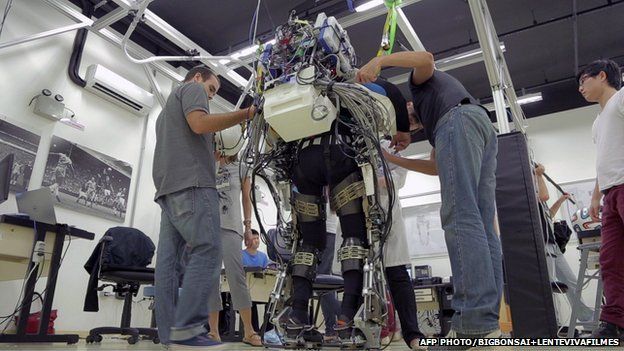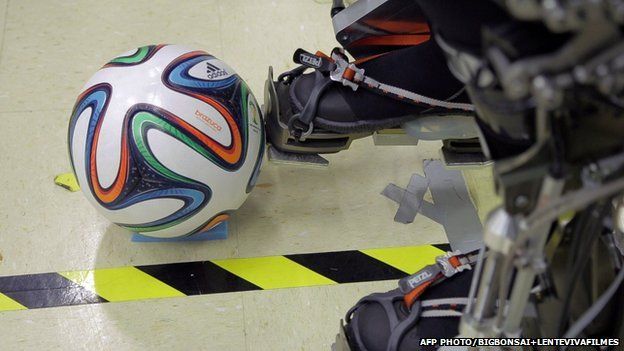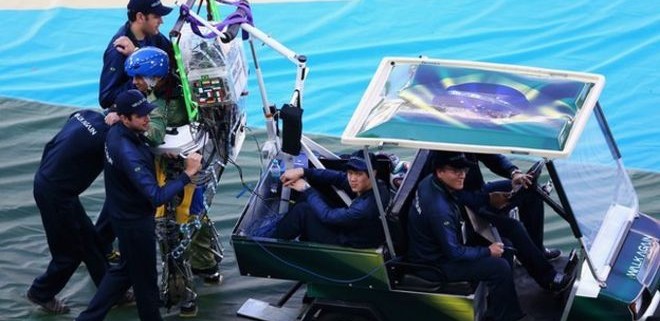Aretech ZeroG is used in the Walk Again Project
Source: BBC
A paraplegic man has made the first kick of the World Cup using a mind-controlled robotic exoskeleton. Juliano Pinto, a 29-year-old with complete paralysis of the lower trunk, performed the symbolic kick-off at the Corinthians Arena in Sao Paulo. Using his robotic suit, Mr Pinto kicked the official ball a short distance along a mat laid down by the touchline.
The identity of the young volunteer was kept a secret until after the event. His robotic exoskeleton was created by a team of more than 150 researchers led by Brazilian neuroscientist Dr Miguel Nicolelis.
Dr Nicolelis tweeted called the event a “great team effort” and afterwards tweeted: “We did it!!!”
“It was up to Juliano to wear the exoskeleton, but all of them made that shot. It was a big score by these people and by our science,” he commented.
The neuroscientist, who is based at Duke University in the US, is a leading figure in the field of brain-machine interfaces. In breakthrough work published in 2003, he showed that monkeys could control the movement of virtual arms on an avatar using just their brain activity.


The scientists have been working under the banner of a consortium called the Walk Again Project. In a statement, the consortium said the World Cup demonstration would be “just the beginning” of a future “in which people with paralysis may abandon the wheelchair and literally walk again”.
Dr Nicolelis had been training eight patients at his lab in Sao Paulo, all of whom were over 20 years of age, with the oldest about 35. “It’s the first time an exoskeleton has been controlled by brain activity and offered feedback to the patients,” Dr Nicolelis, a neuroscientist at Duke University, told the AFP news agency
“Doing a demonstration in a stadium is something very much outside our routine in robotics. It’s never been done before.”
The exoskeleton uses a cap placed on the patient’s head to pick up brain signals and relay them to a computer in the exoskeleton’s backpack.

This then decodes the signals and sends them to the legs. The robotic suit is powered by hydraulics, and a battery in the backpack allows for approximately two hours of use. “The basic idea is that we are recording from the brain and then that signal is being translated into commands for the robot to start moving,” Dr Gordon Cheng, at the Technical University of Munich, who is a member of the team, told the BBC in May.
Dr Cheng led the development of a form of artificial skin for the exoskeleton. This skin consists of flexible printed circuit boards, each containing pressure, temperature and speed sensors. It is applied on the soles of the feet and allows the patient to receive tactile stimulation when walking with the exoskeleton. When the robotic suit starts to move and touches the ground, signals are transmitted to an electronic vibration device on the patient’s arm, which stimulates their skin.
After lots of practice, the brain starts associating the movements of the legs with the vibration in the arm. In theory, the patient should start to develop the sensation that they have legs and that they are walking.
The suit has been named Bra-Santos Dumont, which combines the three-letter designation for Brazil and Alberto Santos-Dumont, the aviation pioneer who was born in the country’s southern state of Minas Gerais.





Leave a Reply
Want to join the discussion?Feel free to contribute!